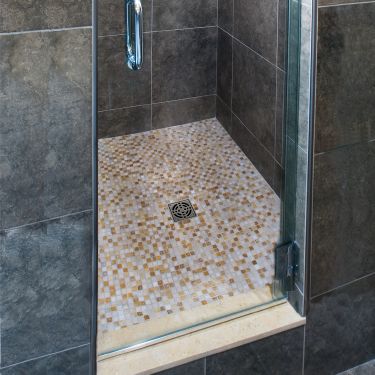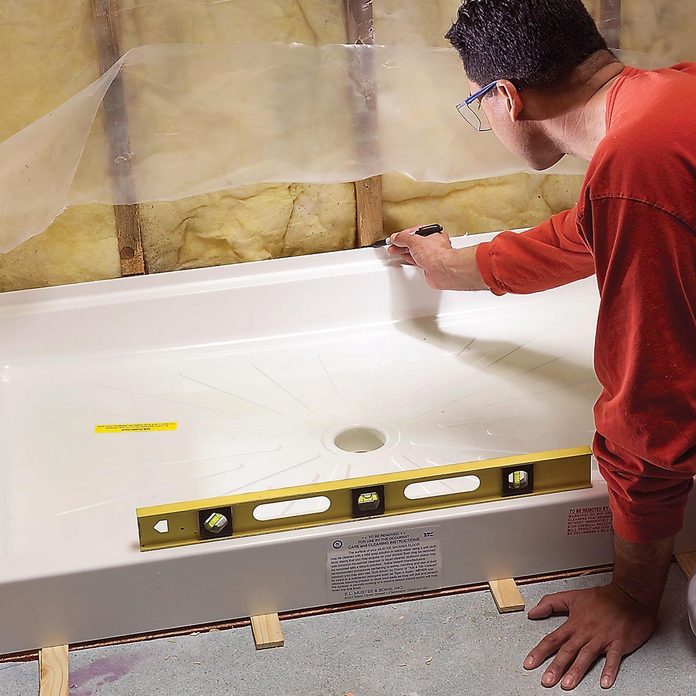We have stumbled on this great article on How to Install a Shower Drain in a Basement directly below on the internet and think it made good sense to relate it with you in this article.

Upgrading a washroom is one of the more preferred home enhancement projects. Managing the plumbing for draining your shower can be exceptionally straightforward unless you overdo.
Managing Your Own Shower Drain Setup Job
You can literally construct a collector for your brand-new shower, yet you actually require to think about it. Do you really wish to enter into the issues of obtaining the sloping proper, as well as making sure every facet of it is water-proof? And I mean every aspect! It is a lot easier to just purchase a pre-cast collector online or at your local Lowes, Home Depot or equipment shop. Building one might seem like a terrific suggestion, however you will most likely feel differently after a number of hours.
Despite how you deal with getting a pan, you must strive to utilize one that has the drain located in the very same place as the initial frying pan. Relocating the drain pipelines can be a task, particularly if the builder used an unique framework structure. If you are figured out to relocate the drain, you are mosting likely to need to cut down the pipeline or extend it, which may mean destroying big chunks of the flooring. Put another way, you are mosting likely to be looking at a multiple weekend project.
Presuming we have our drain aligned, the real link is rather basic. The water drainage pipeline need to be facing vertical approximately the collection agency. It will typically appear like a "U", which means it serves as a cleanout to maintain nasty smells from coming back up from the drain. To link the drainpipe, you are going to create a water limited connection in between a drain cap on the top of the pan as well as the drain pipe. Equipments differ, however you are typically going to do this by placing a coupling piece on the top of the water drainage pipeline. This is then covered with gaskets and also actually screwed into the drainpipe cap. The drain cap ought to function as a locknut, to wit, it screws directly onto the coupling.
The difficult part of this procedure is obtaining your drain cap to suit a water tight setting in the frying pan. This is completed by backing off the drain cap when you make sure every little thing meshes. Then, you put plumbings putty around the bottom of the cap and afterwards screw it back on. The putty should develop a tight seal between the cap and also the shower pan, which keeps water from trickling under it and also into the framing under the shower.
Certainly, restroom showers come in a wide variety of styles nowadays. If you purchase a collector, they often come with plumbing instructions or the shop can keep in mind anything uncommon you must recognize. It appears intricate, yet is commonly rather simple. Have a good time!
Whether you are a bathtub or shower individual, many people try to find shower just options when acquiring a house. This straightforward truth implies more than a couple of homeowners invest a weekend upgrading or setting up showers in their shower rooms. Luckily for you, it is a fairly simple process.
A collector or frying pan refers to the horizontal surface area located at the bottom of the shower. The collection agency usually contains a non-slip surface somewhat banked in the direction of the center or wherever the drainpipe lies. Combined with three to 4 inch walls around the side, the objective of your shower water drainage plumbing is to get the water to move to as well as down the tubes.
How to DIY a Shower Drain Repair or Replacement
Verify the Source of the Leak
Pour some water down the drain using a funnel. If you don’t see signs of leakage from the drain, the leak may be coming from a worn bathtub seal. In this case, fill the bathtub with water and look for leakage between the bottom of the tub and the floor.
Determine What Drain You Need
There are two main types of drains. The options include those with a trip lever, including foot lock, roller ball, and lift and turn drains. Those with trip levers include pop-up and plunger drains. While each may have its own installation guidelines provided by the manufacturer, we’ll continue with the general process of replacing your shower drain.
Access the Drain
If there’s a cover over the drain flange, remove it. Old covers may be stuck in place, so you may need a hacksaw blade to cut it and pry it loose. But if there is no access panel, locate where the shower pipes are, place a cloth or metal plan below where you cut into the wall (to catch any water), and use a drywall saw to cut a panel on your own (you should wear safety glasses if proceeding with this step). You’ll want to cut a piece that can be put back in the same spot after the drain is replaced.
Ideally, you’ll have access to the drain parts through the shower wall. In some cases, the only option is to make an access point through a closet or bedroom.
Remove the Leaky Parts
With the drain exposed, you should see where it is leaking from. There is usually some discoloration in the area of the leak. The drain body, strainer body, or gasket can be removed with pliers while a screwdriver is needed to remove the strainer.
Repair or Replace the Drain
A shower drain repair kit can be purchased at a home improvement store. It will have instructions that will show you how to disassemble and repair the shower drain. Usually, it’s only necessary to fix the parts that are broken. You can combine old and new parts if they fit together. If the entire drain needs to be replaced, swap out all the old parts for the new ones so there are no more leaks.
Test the New/Repaired Drain
Turn on the water lightly while observing how it flows into the drain. Then check the pipes below the shower (in the basement or on a lower floor) to see if there’s any leakage. Once you verify any leak has been fixed, you can go ahead and patch up the wall (using drywall mud and a mud knife).
Ceilings that have water stains should be repaired. Cut away the affected section and replace with a piece of drywall and drywall mud. This eliminates damage caused by the leak and lets you find and mitigate other potential issues such as mold.
https://www.blackhillsinc.com/blog/how-to-diy-shower-drain-repair-replacement/

Hopefully you enjoyed our post about Easy Shower Drain Installation Tips. Thank you for finding the time to read our article post. Those who liked our page kindly don't forget to pass it around. We cherish reading our article about How to Install or Replace a Shower Drain.
Comments on “Diving In with Drainage System Project”